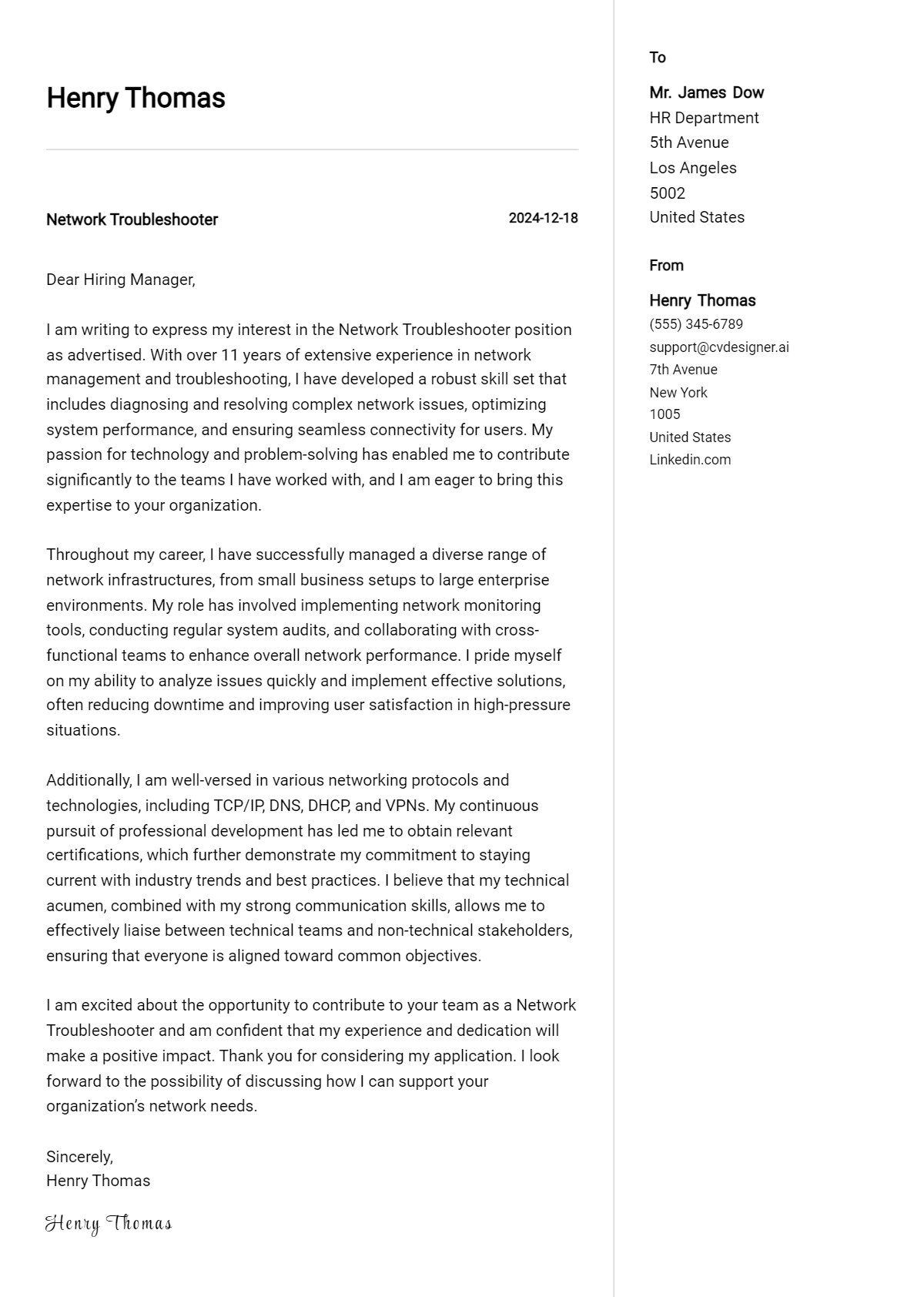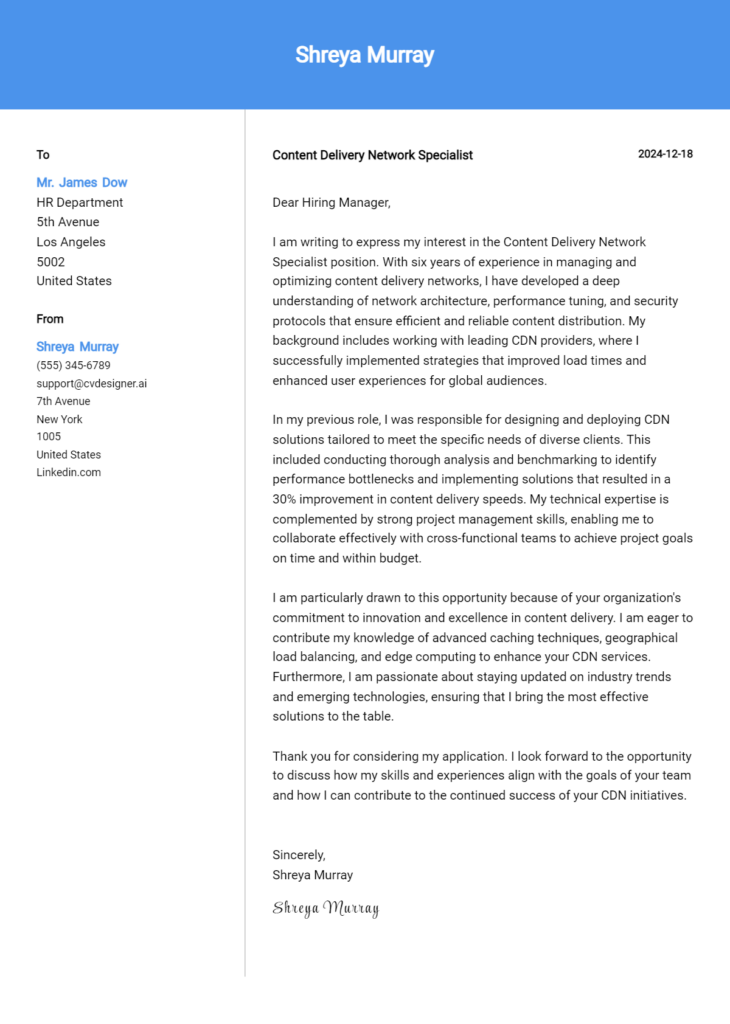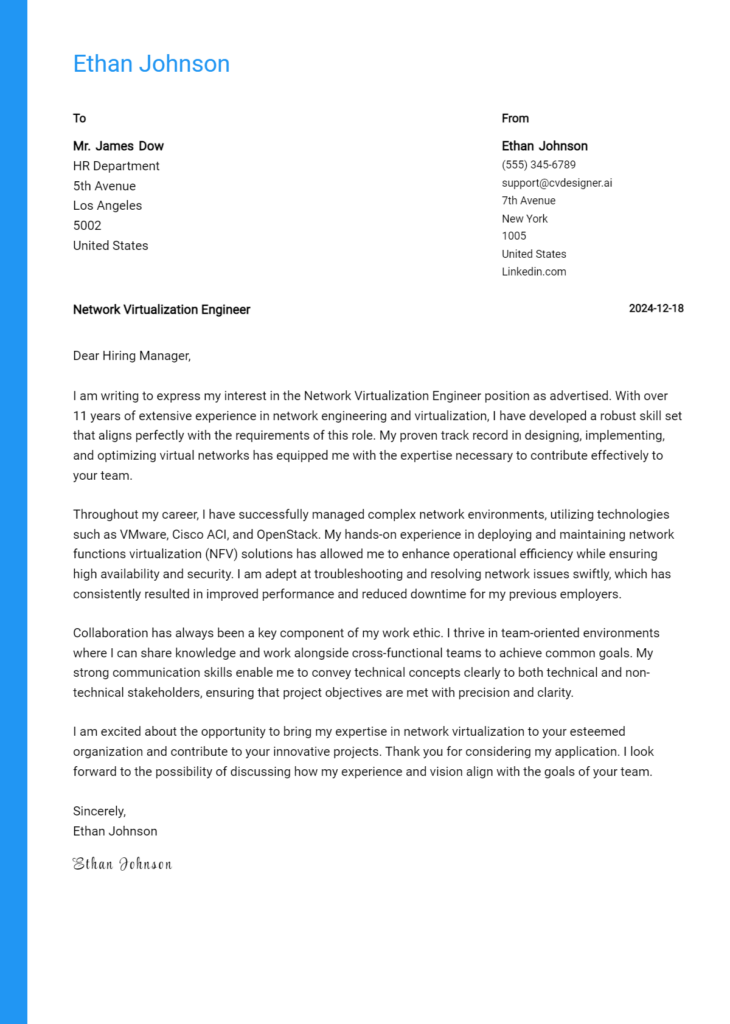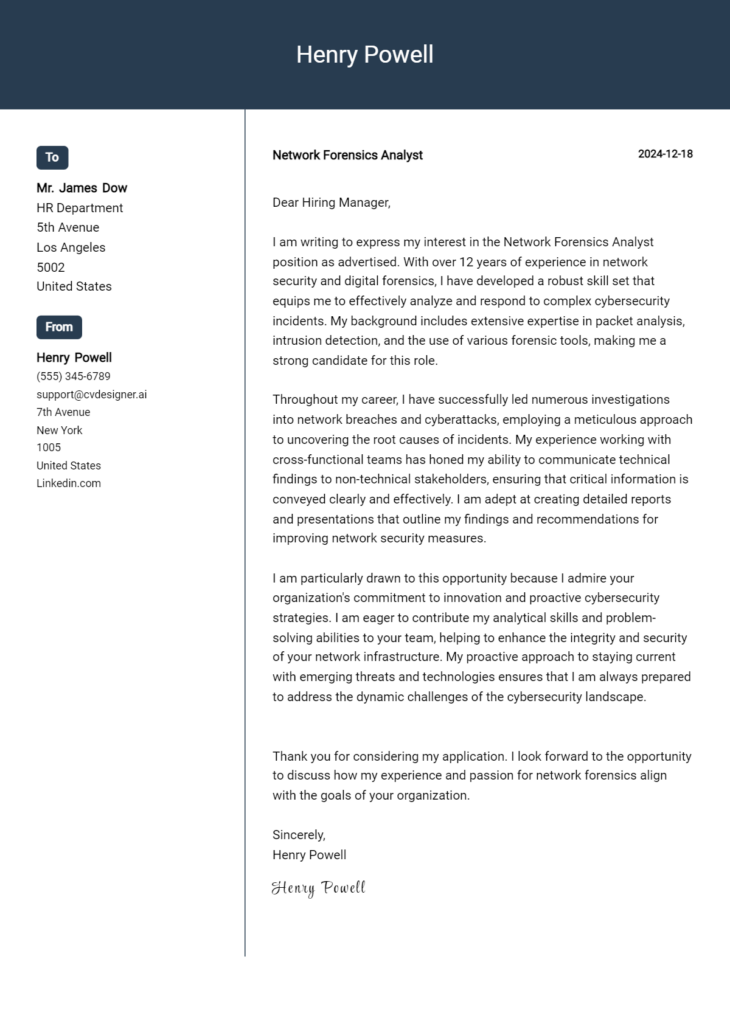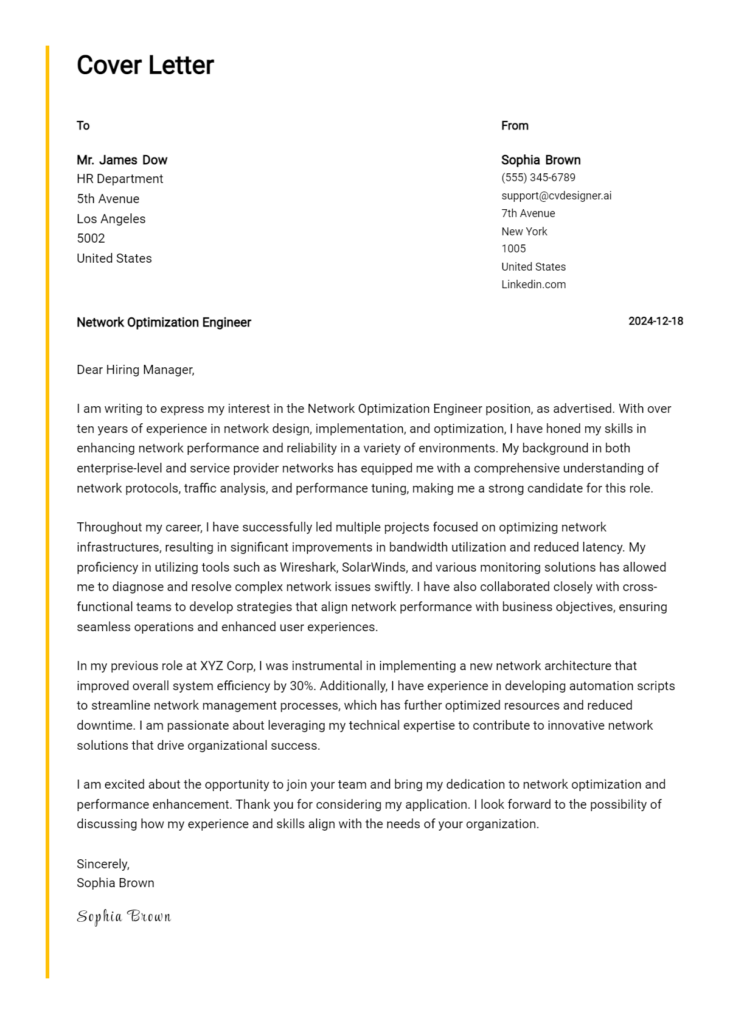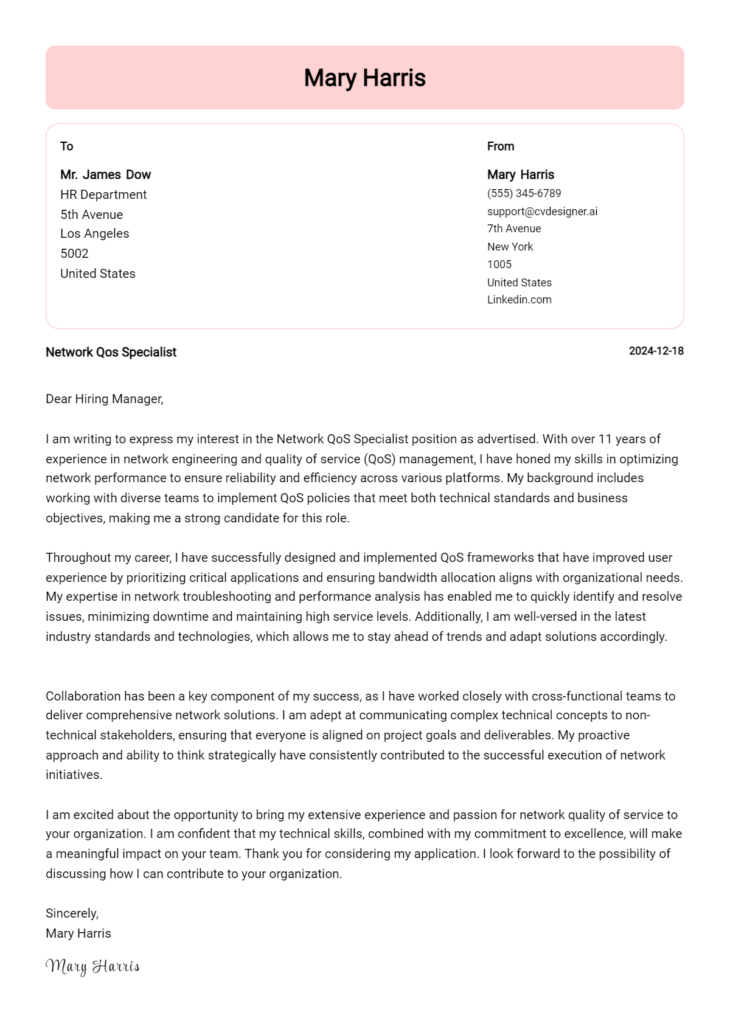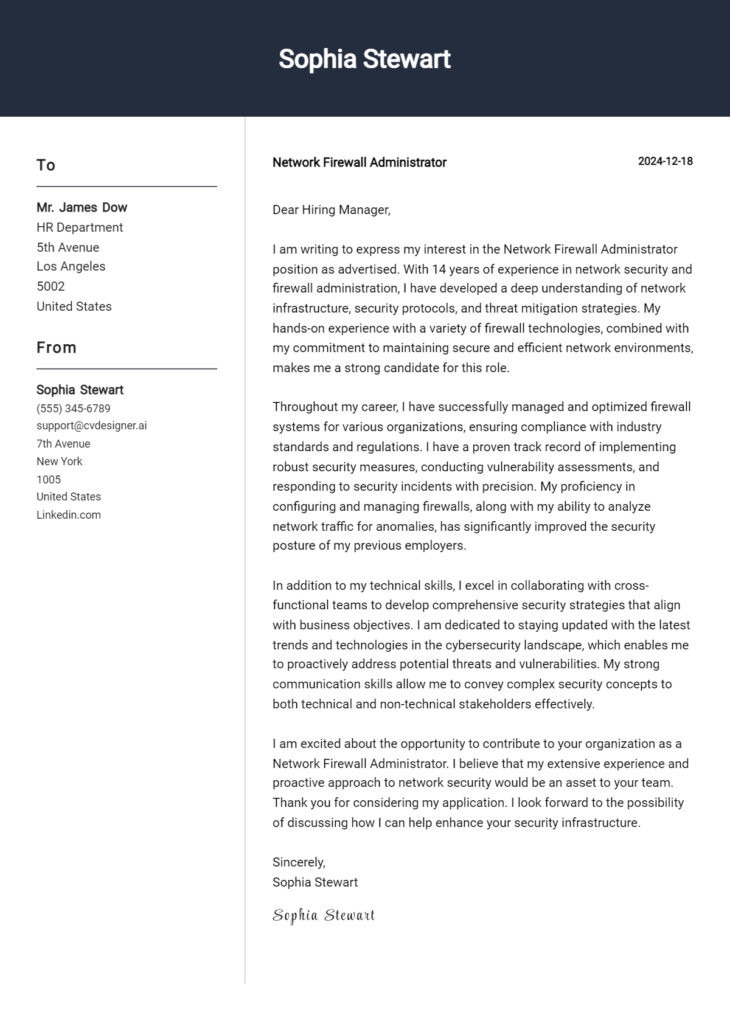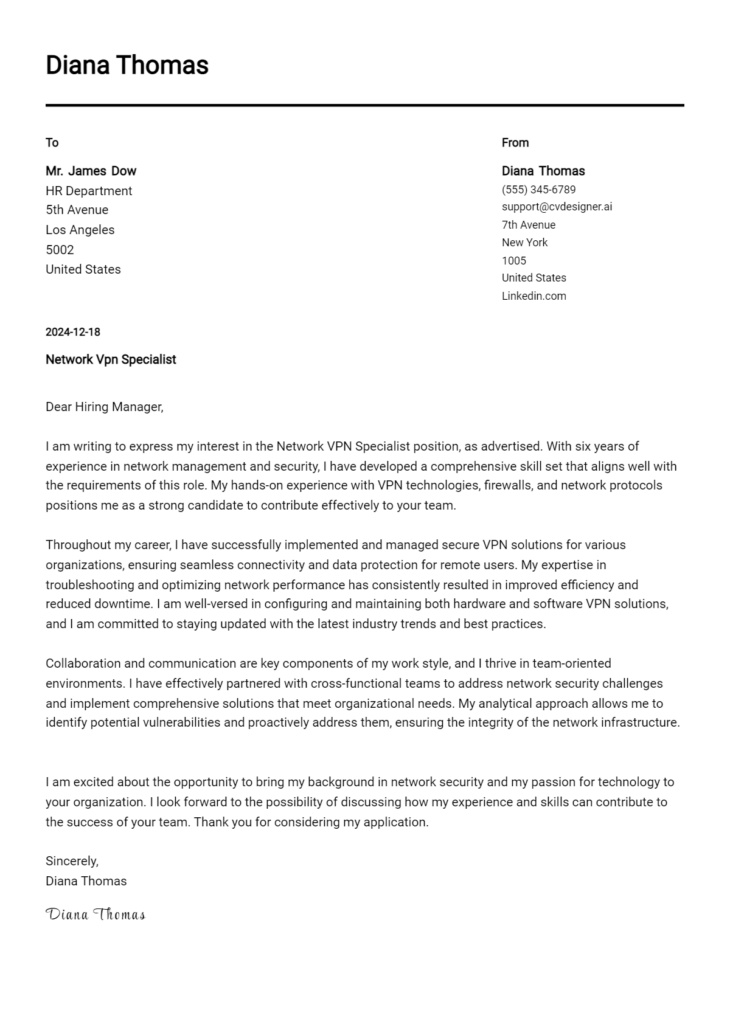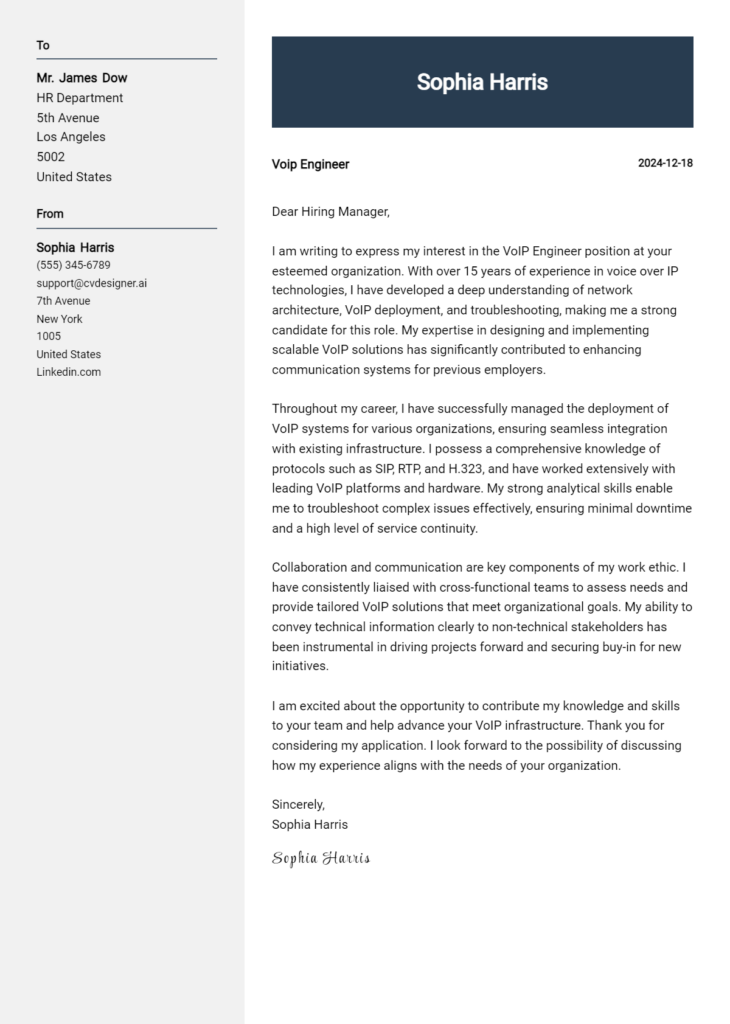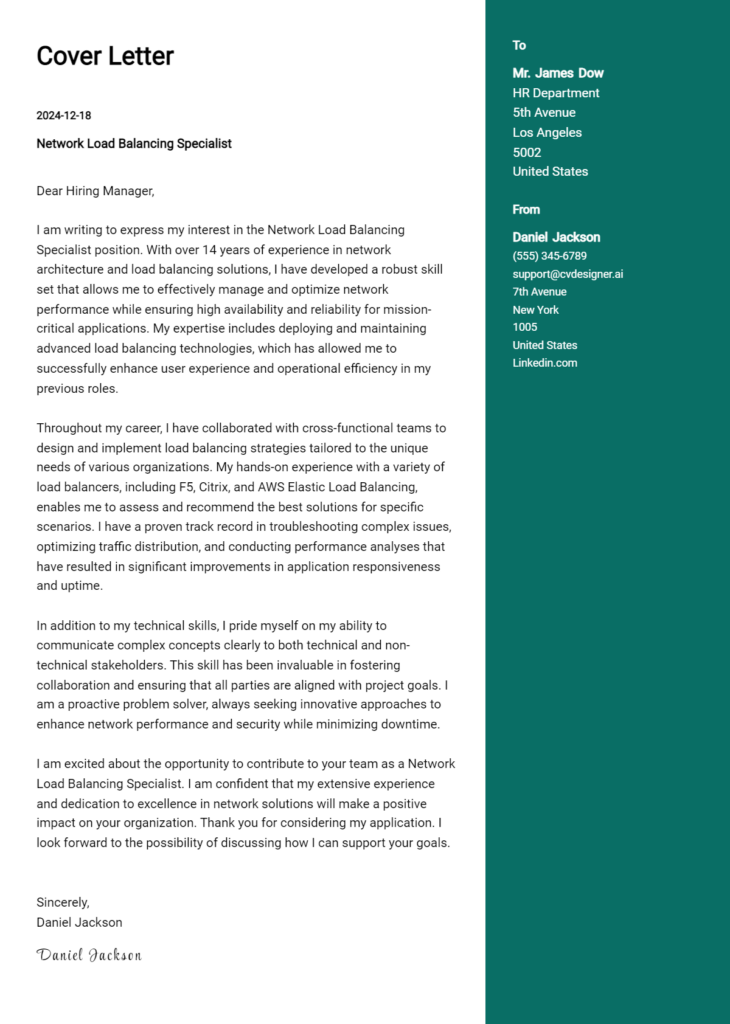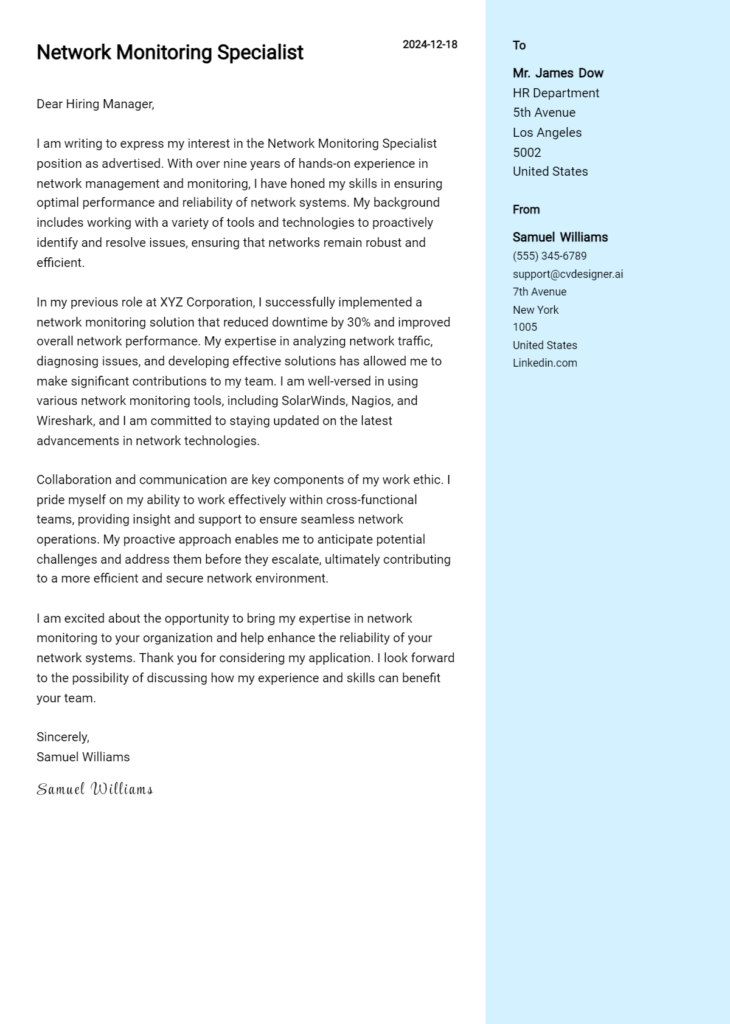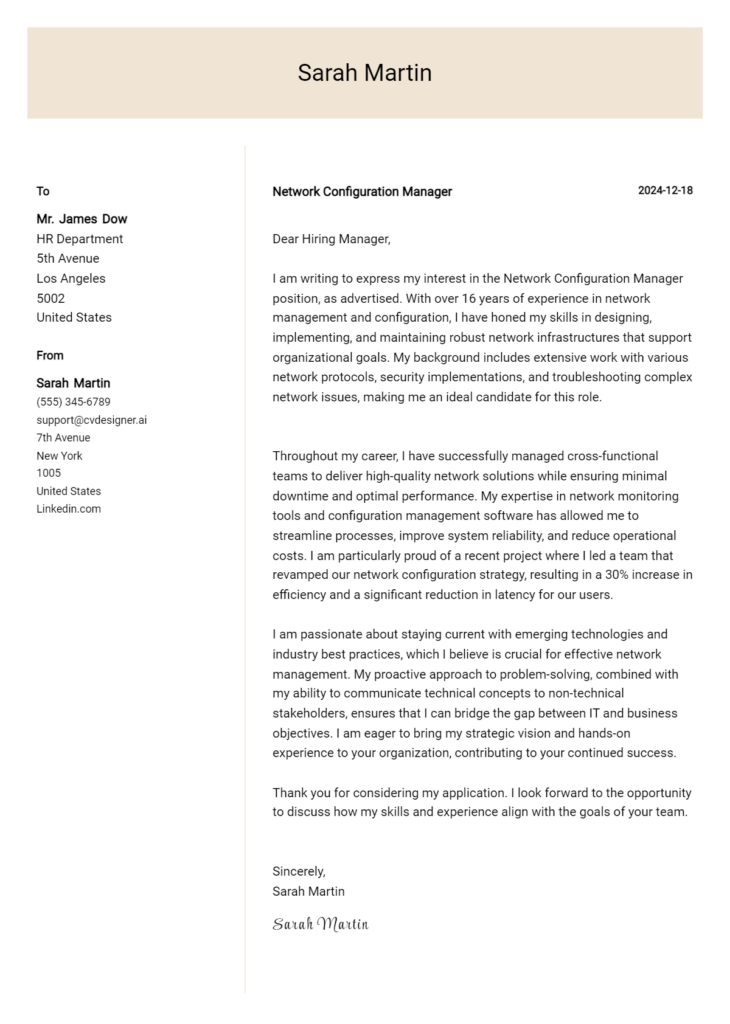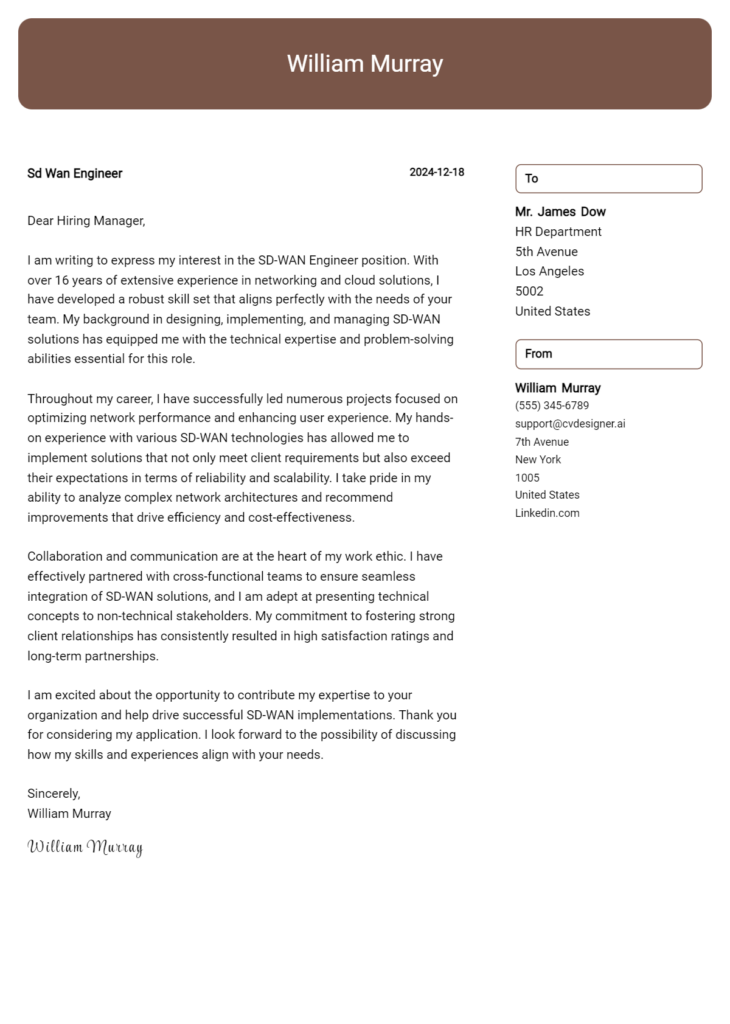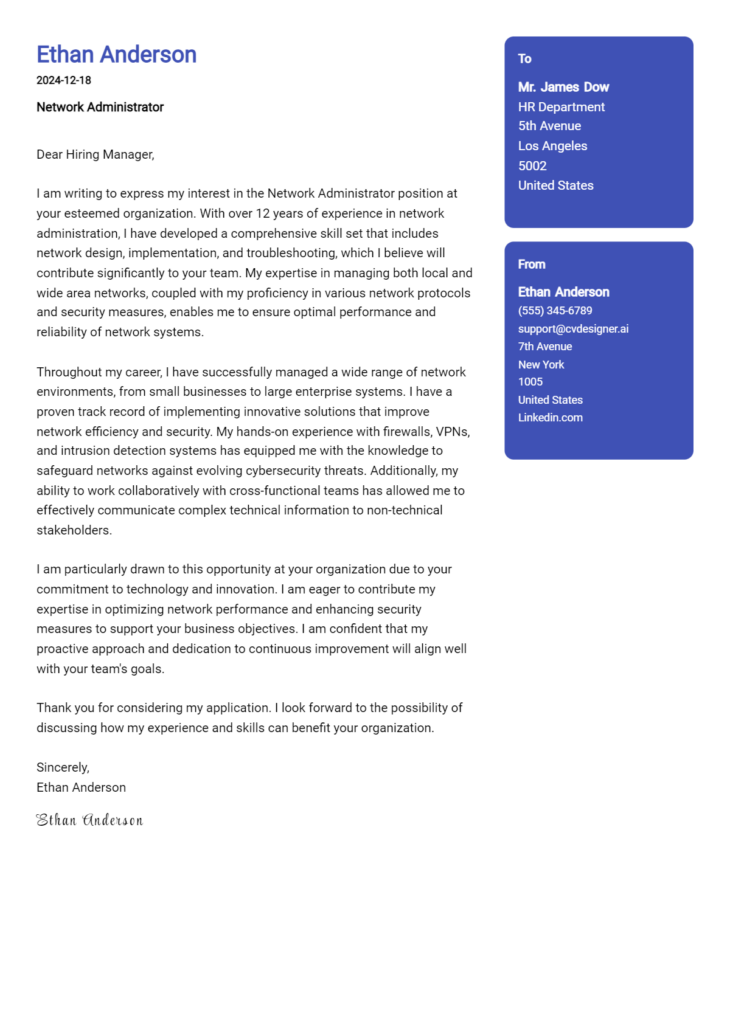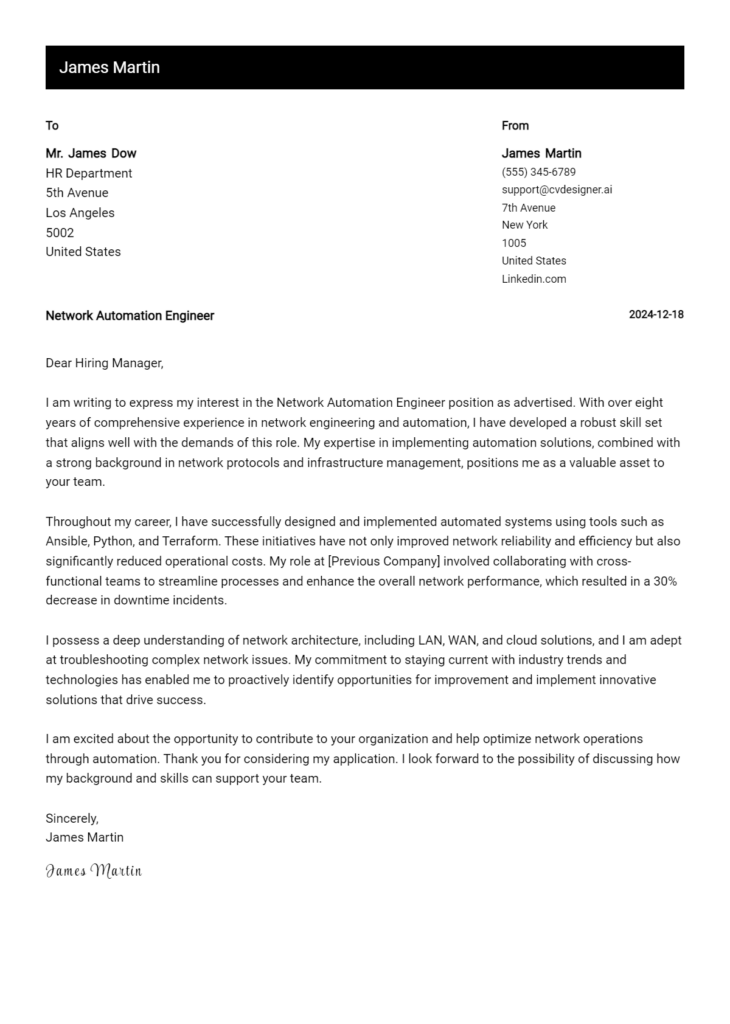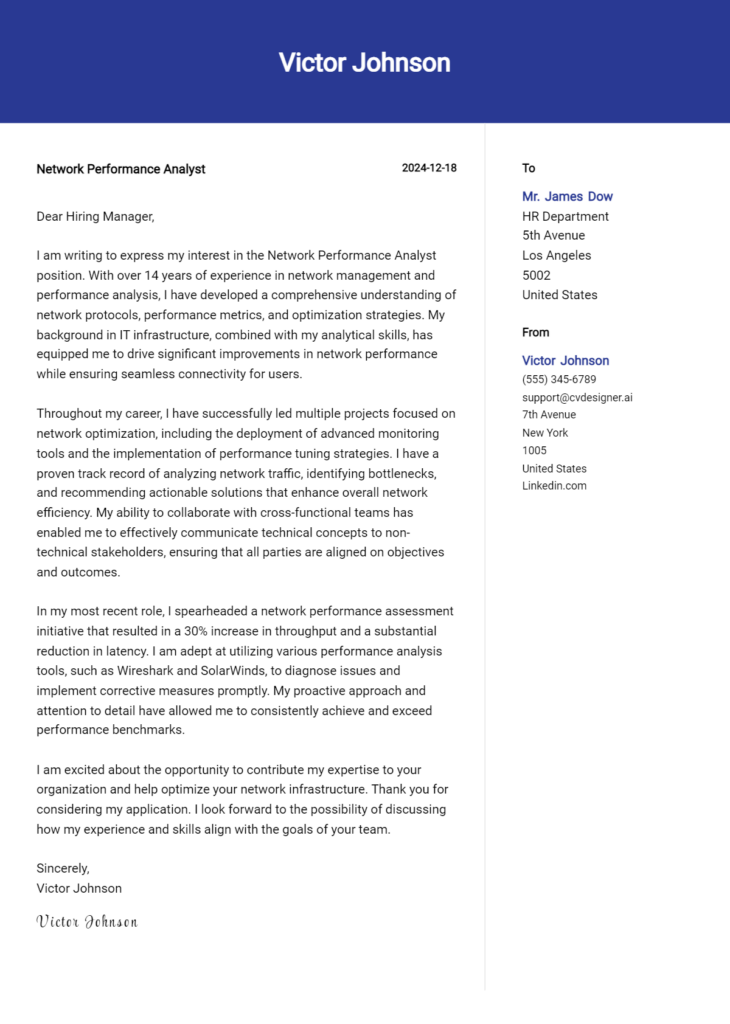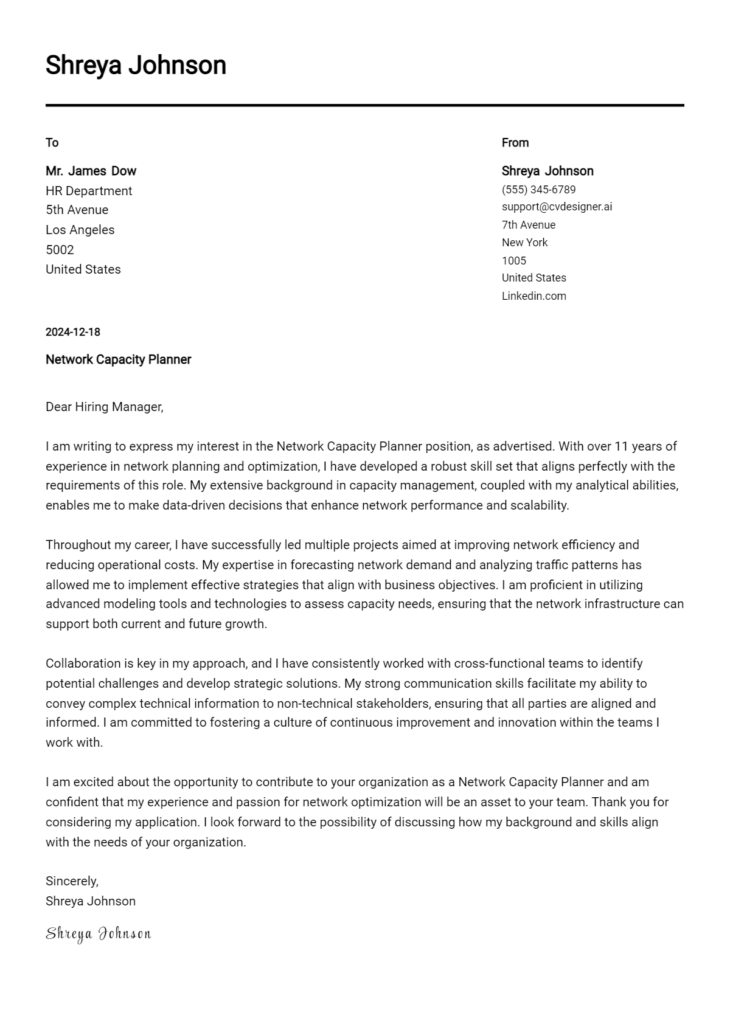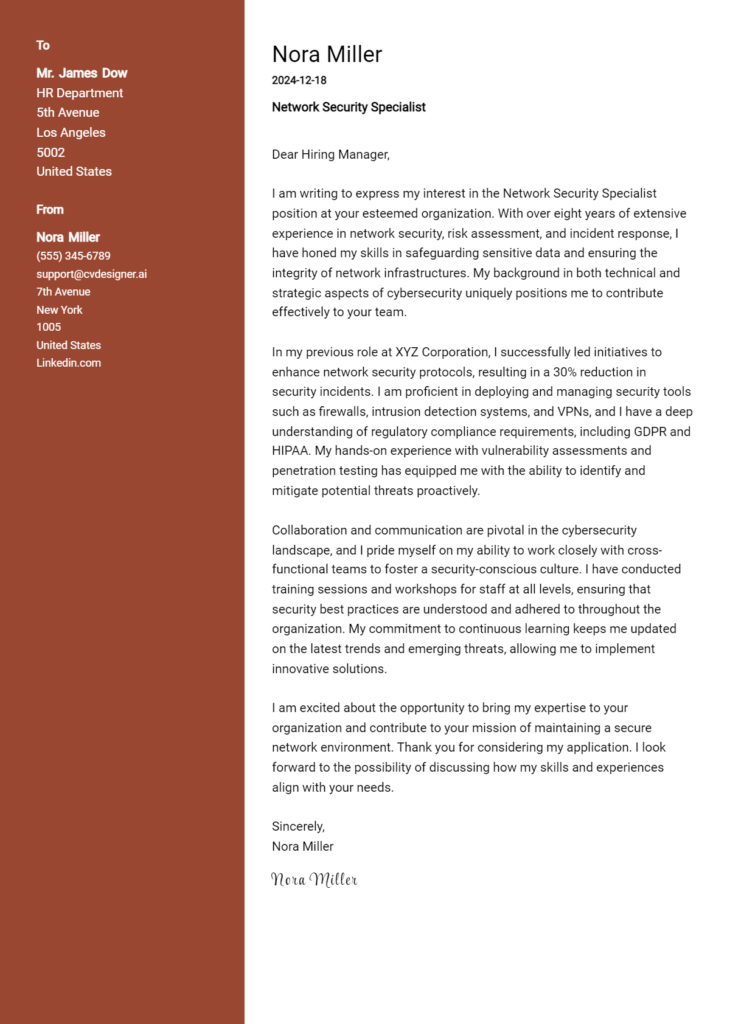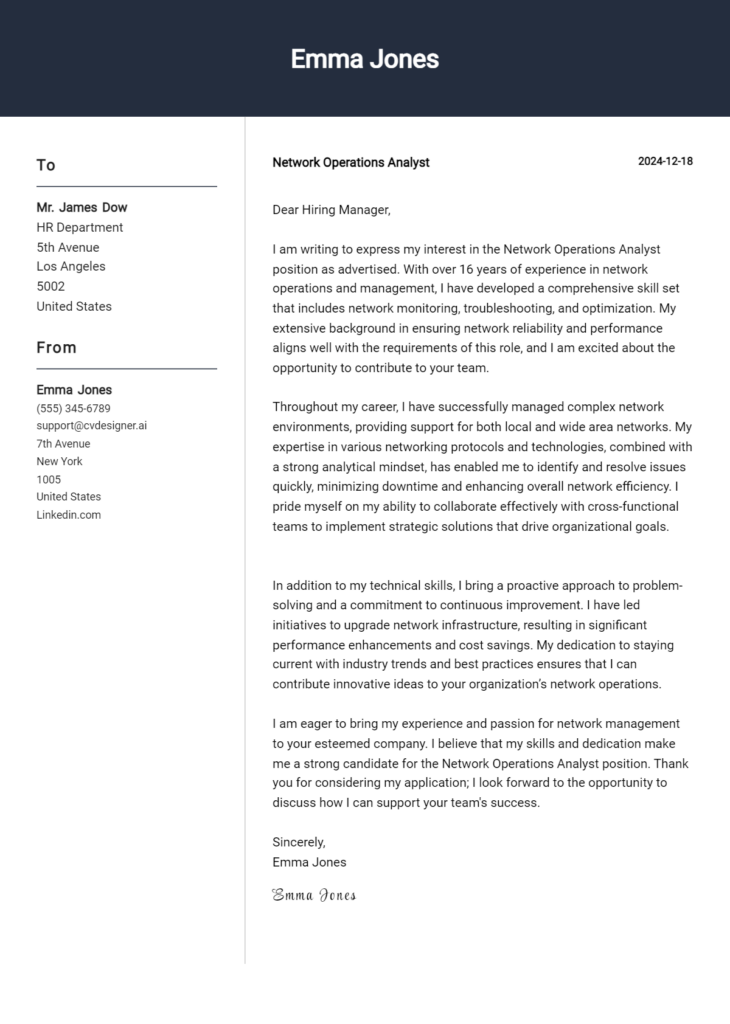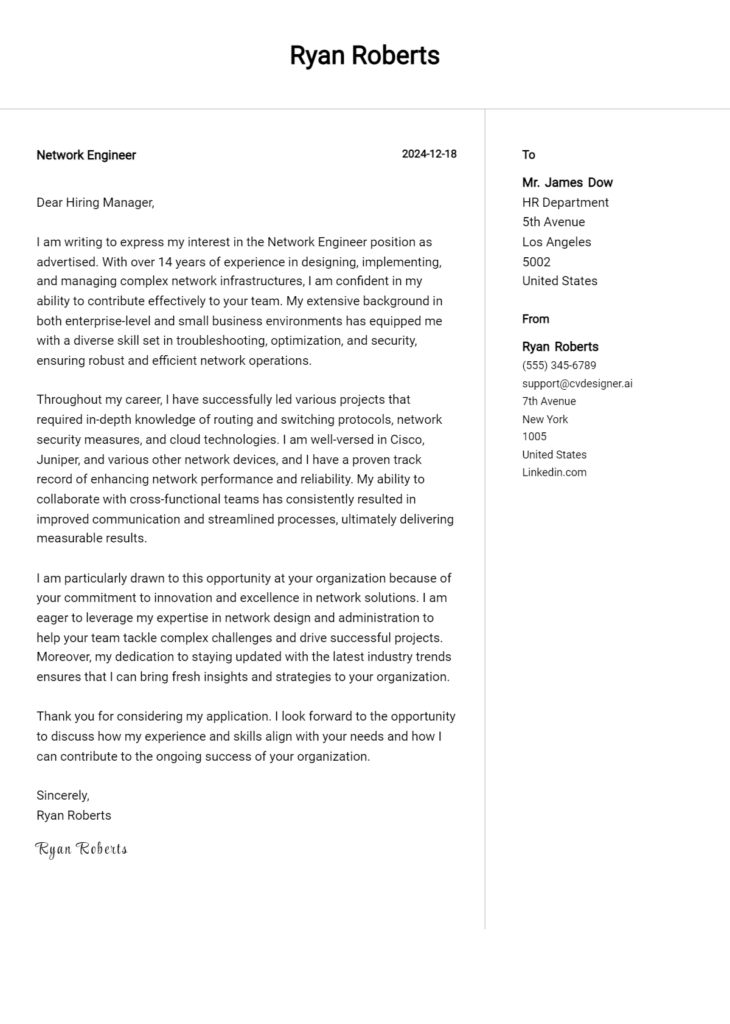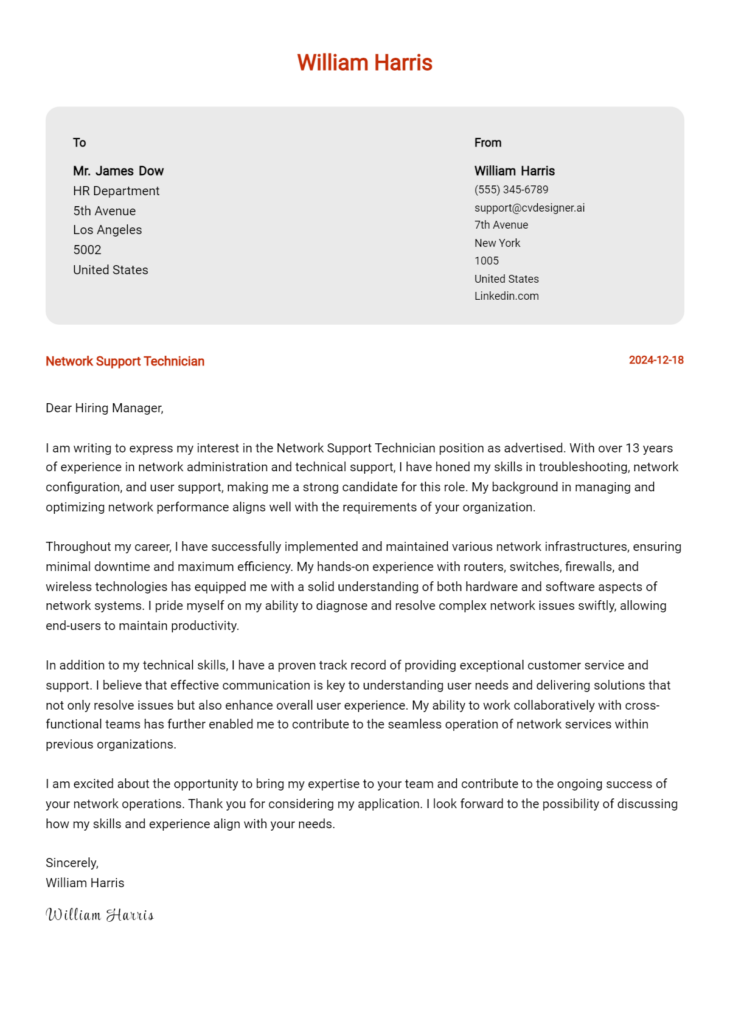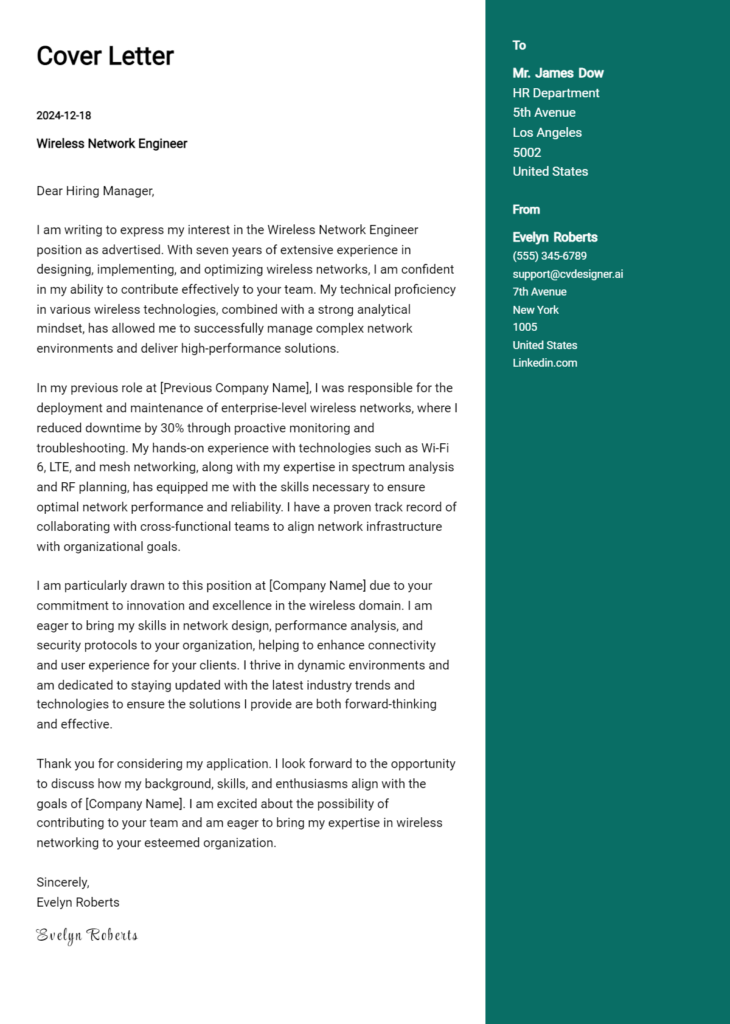Network Troubleshooter Cover Letter Examples
Explore additional Network Troubleshooter cover letter samples and guides and see what works for your level of experience or role.
How to Format a Network Troubleshooter Cover Letter?
Crafting a compelling cover letter is essential for a Network Troubleshooter, as it serves as your first opportunity to demonstrate your technical expertise and problem-solving abilities to potential employers. The way you format your cover letter not only showcases your qualifications but also reflects your organizational skills and attention to detail—critical attributes in the networking field. A well-structured cover letter can effectively capture the hiring manager's attention, illustrating your capability to troubleshoot complex network issues and communicate solutions clearly.
In this guide, we will outline the key components of a professional cover letter, providing insights and examples tailored for Network Troubleshooters.
We'll focus on the essential elements, including:
- Cover Letter Header
- Cover Letter Greeting
- Cover Letter Introduction
- Cover Letter Body
- Cover Letter Closing
Each section is crucial in emphasizing your technical skills and professionalism. Let’s break down each part and explore how to make your cover letter stand out in the competitive field of network troubleshooting.
Importance of the Cover Letter Header for a Network Troubleshooter
The cover letter header plays a crucial role in establishing professionalism and clarity in your application as a Network Troubleshooter. It is the first impression you make on a potential employer and should include essential information such as your contact details, the date, and the recipient's details. A well-structured header not only reflects your attention to detail but also ensures that your application is easily identifiable and organized. A strong header sets the tone for the rest of the cover letter, while a weak one can create confusion and diminish your chances of making a favorable impression.
Strong Example:
John Smith 123 Network Lane Tech City, TX 75001 john.smith@email.com (123) 456-7890 October 1, 2023 Hiring Manager XYZ Tech Solutions 456 Innovation Drive Tech City, TX 75002
Weak Example:
Hey there, I hope you’re doing well! I want to apply for the Network Troubleshooter job.
The Importance of the Cover Letter Greeting
The cover letter greeting is a crucial element that sets the tone for the entire letter. It serves as the first impression of your professionalism and conveys a sense of personalization. By directly addressing the hiring manager, you establish a connection that can help your application stand out. Using a generic greeting can come across as impersonal and may suggest a lack of effort in your application. To demonstrate your commitment and attention to detail, it is beneficial to research the recipient's name and title, which adds a personal touch. When crafting your greeting, avoid phrases like "To Whom It May Concern" and instead seek out specific names whenever possible.
Strong Greeting Example
Dear Ms. Johnson,
Weak Greeting Example
To Whom It May Concern,
By implementing these tips, you can create a strong and engaging start to your cover letter that reflects your enthusiasm for the Network Troubleshooter position.
The Importance of a Well-Crafted Cover Letter Introduction for a Network Troubleshooter
A compelling cover letter introduction is crucial for a Network Troubleshooter, as it serves as the first impression on the hiring manager. This introductory paragraph should succinctly capture attention, demonstrate enthusiasm for the role, and highlight relevant skills or achievements that align with the job's requirements. A strong introduction can set the tone for the rest of the letter, showcasing the candidate's potential to contribute effectively to the team. In contrast, a weak introduction may fail to engage the reader, leading to a missed opportunity. Below are examples that illustrate the difference between strong and weak introductions.
Strong Example
Dear Hiring Manager, I am excited to apply for the Network Troubleshooter position at XYZ Company, where my extensive experience in diagnosing and resolving network issues can significantly contribute to your team's success. With over five years in the field, I have successfully minimized downtime and improved network efficiency for various organizations, and I am eager to bring this expertise to your innovative environment.
Weak Example
Hi, I saw your job posting for a Network Troubleshooter, and I think I could do that job. I have worked with networks before, and I am looking for a new opportunity.
Purpose of the Cover Letter Body for a Network Troubleshooter
The body of a cover letter for a Network Troubleshooter is crucial in demonstrating the candidate's technical expertise, problem-solving abilities, and relevant experiences that directly align with the needs of the company. It should effectively communicate the candidate’s ability to diagnose and resolve network issues, ensuring seamless connectivity and performance. By highlighting specific projects or accomplishments, such as successfully overhauling a network infrastructure or reducing downtime through strategic troubleshooting, candidates can provide tangible evidence of their value. This section serves not only to showcase their skills but also to convey their passion for technology and commitment to maintaining robust network systems.
Strong Example
Dear Hiring Manager, In my previous role as a Network Technician at XYZ Corp, I successfully led a project that reduced our network downtime by 30% through the implementation of a proactive monitoring system. This initiative not only improved overall network performance but also resulted in significant cost savings for the company. My hands-on experience with troubleshooting complex network issues, coupled with my proficiency in Cisco and Juniper technologies, positions me as an ideal candidate for the Network Troubleshooter role at your organization. I am eager to bring my technical skills and dedication to enhancing network reliability to your team. Sincerely, [Your Name]
Weak Example
Dear Hiring Manager, I am applying for the Network Troubleshooter position because I have some experience with troubleshooting. I have worked with networks and can fix some problems. I believe I would be a good fit for your company. I hope to use my skills to help with the network issues you might have. Best, [Your Name]
Importance of the Cover Letter Closing for a Network Troubleshooter
The closing paragraph of a cover letter is crucial as it summarizes the candidate's qualifications, reiterates their enthusiasm for the position, and encourages the potential employer to take the next steps, such as reviewing the resume or scheduling an interview. For a Network Troubleshooter, this closing should reflect their technical skills, problem-solving abilities, and readiness to contribute to the team.
Strong Example
Thank you for considering my application for the Network Troubleshooter position. With my extensive experience in diagnosing and resolving network issues, alongside a strong foundation in network security protocols, I am excited about the opportunity to bring my skills to your organization. I would welcome the chance to discuss how my background aligns with your needs and contribute to your team’s success. Please feel free to review my attached resume, and I hope to hear from you soon to schedule an interview.
Weak Example
I hope you like my resume. I think I would be okay at the job. Let me know if you want to talk, I guess. Thanks for your time.
Writing a compelling cover letter is crucial for candidates aspiring to secure a position as a Network Troubleshooter. This role requires not only technical expertise but also exceptional problem-solving skills, an understanding of the Software Development Life Cycle (SDLC), and the ability to work collaboratively within a team. Additionally, showcasing a commitment to continuous learning can set you apart from other applicants. Here are five tips to help you craft an effective cover letter that highlights these essential attributes.
Tips for Crafting Your Cover Letter
Highlight Your Technical Skills: In your cover letter, be sure to showcase your specific technical skills relevant to network troubleshooting. Mention any certifications you hold, such as Cisco, CompTIA Network+, or other relevant qualifications. Provide concrete examples of how you have applied these skills in past positions to resolve network issues effectively.
Demonstrate Problem-Solving Abilities: Employers value candidates who can think critically and resolve issues efficiently. Use your cover letter to recount a specific instance where you successfully diagnosed and solved a complex network problem. Detail your thought process and the steps you took to address the issue, emphasizing your analytical skills.
Showcase Your Knowledge of SDLC: Understanding the Software Development Life Cycle is essential in network troubleshooting. Discuss your familiarity with SDLC phases and how this knowledge has helped you in past roles. This can include how you collaborate with developers to ensure seamless network integration during application deployment.
Emphasize Teamwork Experience: A Network Troubleshooter often works within a team environment. Highlight your experience collaborating with other IT professionals, such as system administrators and developers. Share a brief story that illustrates your ability to work effectively in a team, showcasing your communication skills and your contribution to achieving common goals.
Express Your Passion for Continuous Learning: The tech field is ever-evolving, and showing a commitment to continuous learning can set you apart. Mention any recent courses, certifications, or training you have pursued to stay updated on network technologies and trends. This demonstrates your initiative and dedication to professional growth, which is highly valued in the industry.
By following these tips, you can create a strong cover letter that effectively communicates your qualifications for the Network Troubleshooter role. For additional guidance, consider exploring cover letter templates or utilizing a cover letter builder to streamline your writing process.
Common Mistakes to Avoid in a Network Troubleshooter Cover Letter
Avoiding common mistakes in a cover letter is crucial for standing out in the competitive field of network troubleshooting. Many applicants fail to highlight their relevant skills or tailor their letters to the specific job, which can diminish their chances of being noticed. Here are some common pitfalls and tips on how to avoid them:
Generic Content: Using a one-size-fits-all cover letter can make you seem unenthusiastic. Always customize your letter for each job application by referencing the company's specific needs.
Lack of Technical Detail: Failing to mention relevant technical skills or experiences can leave potential employers uninformed. Be sure to include specific examples of troubleshooting processes or technologies you are familiar with.
Ignoring Formatting Guidelines: A poorly formatted cover letter can be distracting. Follow a proper cover letter format to ensure your letter is easy to read and professional.
Typos and Grammatical Errors: These mistakes can undermine your credibility. Always proofread your letter multiple times or ask someone else to review it.
Overly Long Letters: Lengthy cover letters can lose the reader's interest. Aim for a concise letter that highlights your qualifications in a clear and engaging way.
Neglecting to Showcase Achievements: Not mentioning your accomplishments can make you seem less competitive. Use quantifiable achievements to demonstrate your impact in previous roles.
Failure to Include a Call to Action: Not inviting the reader to take the next step can make your conclusion weak. End your letter with a strong call to action, expressing your desire for an interview.
By steering clear of these mistakes and referring to useful resources such as cover letter examples, you can craft a compelling cover letter that showcases your qualifications and enthusiasm for the role.
Cover Letter FAQs for Network Troubleshooter
What should I include in my cover letter as a Network Troubleshooter?
In your cover letter, it's essential to highlight your technical expertise in network troubleshooting, including your proficiency with networking protocols, hardware, and software. Mention specific tools and technologies you have experience with, such as Wireshark, Cisco routers, or VPNs. Additionally, showcase your problem-solving skills by providing examples of past challenges you have resolved. Don't forget to express your enthusiasm for the position and the company, indicating how your skills align with their goals. Finally, conclude with a strong closing statement that invites the employer to review your resume and consider you for the role.
How can I demonstrate my problem-solving skills in my cover letter?
To effectively demonstrate your problem-solving skills, share specific examples from your previous roles where you successfully diagnosed and resolved network issues. Use the STAR method (Situation, Task, Action, Result) to structure your examples. For instance, describe a situation where you identified a network bottleneck, the steps you took to troubleshoot it, the solutions you implemented, and the positive outcome that followed. This narrative not only provides concrete evidence of your capabilities but also showcases your analytical thinking and ability to work under pressure, traits that are highly valued in a Network Troubleshooter.
Should I tailor my cover letter for each job application?
Yes, tailoring your cover letter for each job application is highly recommended. Customizing your cover letter allows you to align your skills and experiences with the specific requirements of the job and the company's culture. Start by thoroughly reading the job description and identifying key skills and responsibilities required for the role. Incorporate relevant keywords and phrases into your cover letter to demonstrate that you have the necessary qualifications. Additionally, mention any connections you have to the company or industry, which can help you stand out as a candidate who is genuinely interested in the position.
How long should my cover letter be for a Network Troubleshooter position?
Your cover letter should typically be no longer than one page, ideally around 250-400 words. Aim for three to four concise paragraphs that effectively communicate your qualifications and enthusiasm for the role. Start with a strong introduction that grabs attention, followed by body paragraphs that detail your relevant experience and skills. Use bullet points if necessary to highlight key achievements, but keep the overall format clean and professional. A well-structured, succinct cover letter will make a positive impression on hiring managers and demonstrate your ability to communicate effectively—an essential skill for a Network Troubleshooter.
Build your Cover Letter in minutes
Use an AI-powered cover letter builder and have your letter done in 5 minutes. Just select your template and our software will guide you through the process.

